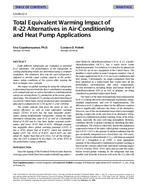Description
Eight different refrigerants are evaluated as potential R-22 substitutes. The performances of the refrigerants in cooling and heating modes are determined using a computer simulation. The volumetric flow rate for each refrigerant is adjusted to provide equal cooling capacity at the performance rating conditions of the system while keeping the heat exchanger sizes constant. The impact on global warming by using the refrigerants is determined based on both the direct contribution (assuming a 4% annual leak rate) as well as the indirect contribution from energy use arising from CO2 production at the power generation stage. The amount of CO2 produced is determined based on current United States energy production and consumption data and is evaluated to be 0.191 kg/MJ (1.234e-4 lb/Btu). The results indicate that from the point of view of energy efficiency as well as total equivalent warming impact (TEWI), R-410A has the most favorable performance among nonflammable refrigerants. Among the eight alternative refrigerants, pure R-32 as well as a flammable blend of R-290 and R-134a have higher seasonal performance and lower TEWI than R-410A. Although propane has negligible direct global warming potential (GWP), it has a TEWI almost that of R-407C, which has relatively higher GWP. The TEWI of R-407C and R-407E are only about 4% higher than that of R-410A. For all the refrigerants, the GWP is found to be less than 7.5% of the TEWI at the performance rating conditions.
Units: Dual
Citation: Symposium, ASHRAE Transactions, vol. 105, pt. 1
Product Details
- Published:
- 1999
- Number of Pages:
- 7
- File Size:
- 1 file , 360 KB
- Product Code(s):
- D-7636




